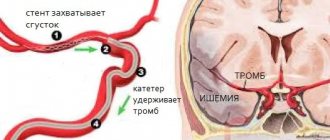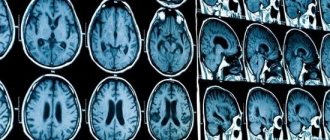1.General information
Obviously, there is no need to describe in detail the key role and countless functions of the brain in the human body. Let us only note that the central nervous system, i.e. The brain and spinal cord are an incredibly complex organ that controls absolutely all processes, including the activity of the endocrine glands (which, in turn, regulate the functioning of internal organs through hormones). For the most part, this control by the central nervous system is carried out automatically, without the participation of consciousness. However, the neural tissue of the brain, like any other living tissue, can perform its functions productively only if there is a constant supply of nutrients and energy, i.e. oxygen necessary for redox biochemical reactions. The brain receives all this through the bloodstream. And if for some reason the flow of arterial blood enriched in the lungs is sharply reduced or completely blocked, a catastrophe will very soon occur in this area, in the literal sense of the word.
Ischemia (lack of blood supply) triggers dystrophic and degenerative changes (structural and functional degradation of tissue, which, against the background of constant starvation, copes with its tasks increasingly poorly); then atrophy occurs - gradual death and reduction in volume. In the event of a sudden interruption (ischemic attack), if the blood supply is not restored quickly enough, necrosis begins - mass death of specialized cells. In general, this terrible phenomenon is called “infarction” (of the myocardium, kidney, spleen, etc., including the brain), however, in relation to the central nervous system, the term “stroke” (literally “stroke”, more accurate modern) is more often used term – stroke, i.e. acute cerebrovascular accident). Strokes are divided into two unequal groups: rarer hemorrhagic strokes (hemorrhages), caused, for example, by the rupture of a congenital arterial aneurysm, and ischemic strokes (over 80% of all strokes), associated with restriction or blocking of blood flow through the vessels supplying the brain.
A must read! Help with treatment and hospitalization!
Headache
Encephalitis
Tick-borne encephalitis
Polio
Hypercholesterolemia
19529 July 31
IMPORTANT!
The information in this section cannot be used for self-diagnosis and self-treatment.
In case of pain or other exacerbation of the disease, diagnostic tests should be prescribed only by the attending physician. To make a diagnosis and properly prescribe treatment, you should contact your doctor. Headache - causes, what diseases it occurs with, diagnosis and treatment methods. The basis of headaches is irritation of pain receptors located in:
- dura mater and cerebral vessels;
- periosteum of the skull, vessels of the soft tissues of the head, muscles.
The brain tissue itself does not contain pain receptors.
Types of headaches (cephalgia)
Headaches are divided into primary and secondary. A headache is considered primary if it is the main manifestation of a brain disease, such as in migraines and tension headaches.
Secondary headache is a symptom of other disorders, for example, head trauma, chronic cerebral ischemia, viral diseases, diseases of the cervical spine, etc.
Let's look at the four most common types of headaches.
Possible causes
Tension headache
Tension headache is the most common form of primary headache. Psycho-emotional stress, depression, anxiety and various phobias, overstrain of the muscles of the shoulder girdle - these are the main causes of tension headaches. Migraine headache
Migraines occur in women about three times more often than in men, and about 60-70% of all migraine cases in women are so-called menstrual migraines. However, the causes and mechanism of development of migraine attacks are not completely clear. At any age, in both men and women, migraine attacks can be provoked by emotional and physical overload, eating disorders, drinking alcohol, changes in weather conditions, sharp noise, strong odors, etc. Headache with colds
Headaches from colds are caused by hyperthermia and the damaging effects of microorganism toxins on brain cells. Headache in chronic cerebral ischemia
The cause of this pain, which is the most common secondary headache in elderly patients, is cerebral vascular pathology, in which blood circulation is disrupted and blood supply to brain tissue deteriorates.
The result is progressive brain dysfunction.
What diseases cause
tension headaches?
Tension headaches are caused by irritation of structures in the central nervous system (CNS) called the nociceptive system. Myogenic, stress, and psychogenic headaches are tension headaches.
Most often, tension headaches occur at a young and working age.
In cases of tension headaches, a person experiences bilateral, usually not strong, pressing and squeezing, monotonous and dull headaches. Attacks of such pain are accompanied by fatigue, nervousness, impaired appetite and sleep, and decreased performance. The duration of the attack is from 30 minutes to several days.
Migraine headache
Indicates only one disease - migraine, since attacks of such cephalgia have a peculiar character. Migraine pain is paroxysmal, throbbing, of moderate or severe intensity. It covers half of the head.
The pain may intensify with physical activity, tilting the head, and is often accompanied by nausea and vomiting.
Bright light, sharp sound, strong smell increase the pain. A migraine attack may be preceded by an aura, a collection of visual, auditory, olfactory or other neurological symptoms that lasts up to one hour.
Headache due to colds
Occurs in most acute and chronic diseases of the upper and lower respiratory tract caused by bacteria or viruses. In some cases, the intensity of such cephalgia correlates with the severity of fever, severity of cough, sore throat and other symptoms. The pain most often spreads throughout the head. Headache in chronic cerebral ischemia
The concept of chronic cerebral ischemia includes: discirculatory or vascular encephalopathy (slowly progressive cerebrovascular accident), cerebrovascular insufficiency (pathology of cerebral vessels), vascular dementia (a disorder that causes organic damage to the brain). In the clinical picture of chronic cerebral ischemia, dizziness, decreased cognitive function, emotional lability (unstable mood), motor-coordination disorders, and perception disorders (tinnitus, “floaters” before the eyes) become indispensable companions of headaches. Headaches are usually not severe, spread over the entire head, and last for a long time. Diagnostics and examinations
Tension headache and migraine headache, headache with colds
The diagnosis is made by a neurologist based on anamnesis and assessment of the patient’s complaints. Headache in chronic cerebral ischemia
Radiation examination is key for chronic cerebral ischemia (ultrasound Dopplerography of cerebral vessels)
2. Reasons
Considering the critical, priority importance of the brain, evolution took care of its maximum protection: powerful skull bones, upper location, as well as “reserve circuits” of cerebrovascularization (blood supply to the brain). The brain receives nutrition from several main vessels - the carotid and vertebral arteries; the latter, merging, form the unpaired basilar artery, or vertebrobasilar arterial system. If there are disturbances in any of the blood supply channels, other channels compensate for the deficiency in order to preserve the functioning of the brain at any cost. The compensatory capabilities of the brain in this sense are very great (and have not yet been sufficiently studied), however, unfortunately, they also have their limits. With intense sudden ischemia, the cerebrovascular system simply does not have time to react and prevent irreversible necrotic changes.
Spasm of the main cerebrovascular vessels can occur for various reasons: massive bleeding, sudden blow, rapid hypothermia, poisoning with certain substances, etc. However, all these factors occupy only a small proportion compared to the leading cause of ischemic stroke: embolism, i.e. blockage of the arteries by a detached atherosclerotic plaque, a clot of coagulated blood, etc. In general, arterial hypertension and atherosclerosis, lipid metabolism disorders with the accumulation of mushy deposits on the walls of blood vessels, are typical “diseases of civilization”, since they are largely caused by the very lifestyle and destructive habits of modern man: physical inactivity, extremely unhealthy diet and overeating, smoking etc. It is no coincidence that circulatory disorders in various systems of the body (primarily the coronary and cerebral arterial systems) consistently occupy first place in the lists of causes of non-violent mortality.
Visit our Neurology page
Causes of cerebral vascular spasms
Like any disease or pathological condition, spasm of the blood vessels of the brain has its causes. This condition has been studied quite thoroughly, and knowing the etiology (origin) of this disease is extremely necessary, because treatment of vasospasm is always symptomatic.
The causes of vasospasm in the brain (cerebral vasospasm) can be divided into two groups of etiological factors: cerebral and extracerebral.
- Brain: Atherosclerosis. Atherosclerosis is the process of formation of the so-called atherosclerotic “plaque” on the inner vascular wall (endothelium). In essence, a plaque is an accumulation of clumped elements of circulating blood and various salts and fats. As a result of recent studies, it was found that atherosclerosis already affects 90% of adolescents aged 14 to 16 years around the world. This, of course, is due to the dietary habits and lifestyle of modern people, as well as a number of aggressive environmental factors.
- Hemorrhages in the brain. In these conditions, a reflex vasoconstriction occurs. The process takes some time, but ultimately ends with a complete narrowing of the damaged vessel, and as a result, a stoppage of blood supply.
- Osteochondrosis. As a rule, vasospasm occurs with osteochondrosis in the cervical vertebrae. This process entails a narrowing of the lumen of the vessels supplying blood to parts of the brain. Thus, as a result of a decrease in the volume of incoming blood, vasospasm occurs.
- Cerebral aneurysm. These are various changes and defects in the structure of the walls of blood vessels in the brain.
- Vasculitis (angiitis). Pathological changes in blood vessels are based on inflammation, which can be primary (independent) or secondary (as a symptom or complication of certain diseases).
- Vascular embolism. This should include thromboembolism as the most common cause of cerebrovascular accidents. Thromboembolism is a pathological condition in which a blood vessel is blocked by a blood clot. In this condition, spasms in the blood vessels of the brain are also noted.
- Tumors and tumor-like diseases of the head. In such conditions, spasm occurs due to compression of the vessel by the tumor.
- Circulatory disorders in diseases of the cardiovascular system (cardiovascular system). As a rule, vasospasms of the brain occur in diseases such as ischemic heart disease (coronary heart disease), chronic heart failure, and increased vascular stiffness.
- lack of sleep;
At the MART clinic on Vasilyevsky Island
- Experienced doctors (including those practicing in the USA and Europe)
- Prices affordable for everyone
- Expert level diagnostics (MRI, ultrasound, tests)
- Daily 8:00 — 22:00
Make an appointment
3. Symptoms and diagnosis
The clinical picture of blockage of the blood vessels supplying the brain can vary over a very wide range.
Symptoms depend, first of all, on the location and extent of the ischemic area. Early warning signs may include frequent dizziness and headaches, decreased memory and intellectual productivity, presyncope and sudden short-term fainting (syncope), false tactile sensations (paresthesia).
With more pronounced pathology, numbness, partial paralysis, certain speech disorders (articulation disorders, inability to quickly update the necessary words, impoverishment of vocabulary), various dysfunctions in the field of recognition, coordination of movements and spatial orientation, fine motor skills (in particular, writing) are added. , emotional response, behavior, physiological processes and many others.
With stroke, the same focal symptoms develop, by definition, acutely, catastrophically; Unlike disorders of brain activity during transient attacks or crises, such symptoms are persistent.
Diagnosis of suspected thromboembolism includes a mandatory consultation with a neurologist, as well as, if indicated, a number of related specialists (cardiologist, neurosurgeon, etc.). The most informative instrumental research methods are X-ray contrast multislice computed tomography (MSCT in angiographic mode), Dopplerography (ultrasound assessment of the patency of the great vessels), and MRI angiography.
About our clinic Chistye Prudy metro station Medintercom page!
Diagnosis of cerebral vasospasm
The diagnosis is made by a specialist based on symptoms, as well as instrumental and hardware research methods. When diagnosing cerebral vascular spasm, the most informative methods are:
- MRI (magnetic resonance imaging) of the head and neck;
- Contrast magnetic resonance imaging of blood vessels (angiography). This method uses the introduction of special contrast agents into the bloodstream.
Can also be used:
- magnetic resonance imaging
- Doppler examination using ultrasound (less informative research method).
4.Treatment
For partial, chronic, gradually progressive disorders of cerebral circulation, it is prescribed strictly according to indications and taking into account a number of individual factors, i.e. self-medication is strictly contraindicated and deadly! – various effective therapeutic regimens, including stimulants of cerebral hemodynamics and neurometabolism (nootropics), protectors of cognitive functions, thrombolytics, antiplatelet agents, vitamin complexes.
It is mandatory to normalize your lifestyle, exercise and sleep patterns, and give up bad habits.
However, in the most acute and severe cases of embolism, the only choice is neurosurgical intervention to restore the patency of the cerebrovascular vessels and eliminate the consequences of ischemia. At the same time, timely seeking specialized help and strictly following the recommendations of a neurologist in most cases allows one to avoid such an outcome. The brain is not an organ that can be risked by waiting for natural or non-medical healing.









